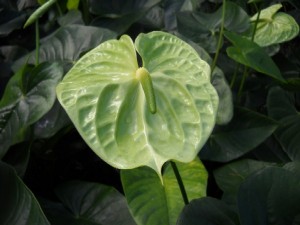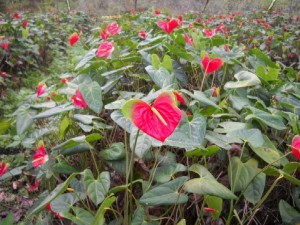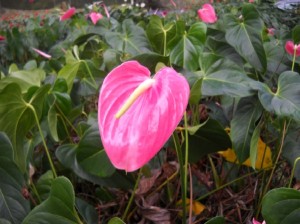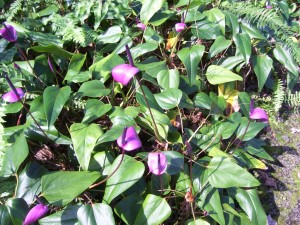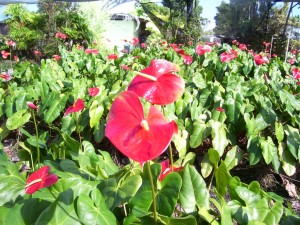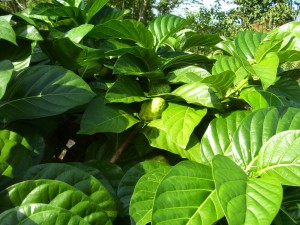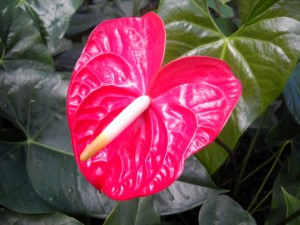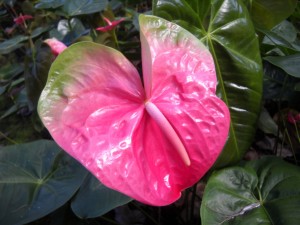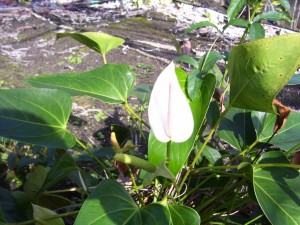Green Anthurium
Have green anthurium flowers or plants delivered right to your doorstep. We grow these green midori anthuriums on the slopes of the Kilauea Volcano. We sell flowers for $3.50 per stem and plants for $29 per top cutting. Click Here to Order Now.
Flowers
Midoris are one of the more durable anthurium flowers. They are slightly sturdier and a little more difficult to crease or bruise, so they hold up to shipping very nicely. They are also one of the longer lasting varieties and have a vase life of several weeks. When these flowers are left on the plant, rather than cut, they tend to develop reddish, copper colored highlights that can make them look even more attractive. The word “midori” is Japanese for the word “green,” so this is an apt moniker for them.
Plants
Green Midori anthuriums were developed by an anthurium breeder known as Calvin Hayashi in 1985. He did a very good job on this variety as they grow very energetically and their internodes are on the shorter side, so they aren’t as unwieldy as other varieties. We grow quite a number of these plants on our farm as their flowers are in very high demand.
Mickey Mouse Anthurium
Mickey Mouse Anthurium flowers are small red and green butterfly anthuriums. They have dark red centers and green “ears.” Perhaps they got their name from Disney’s famous mouse, but since his name is probably trademarked, I suspect they got their name from the pejorative slang term, which means small-time or trivial, instead. After all they are small in size.
But there’s nothing trivial about these flowers. They may be small, but they are still very beautiful. These anthurium plants like to throw off a lot of off shoots so one plant tends to multiply into several plants very quickly and may end up producing several stunning flowers at a time.
Pink Anthurium Flowers
Pink symbolizes grace and youthfulness. So Pink Anthurium Flowers make an ideal gift for a joyful friend who is the epitome of youthful innocence and gentility. Our flowers grow on a small farm on the island of Hawaii that is only a few miles away from the Kilauea Volcano. Each of these lovely Pink Anthuriums costs only $3.50 per stem. While our Pink Marian Seefurth Anthurium Plants are priced at $29 per top cutting.
Click Here To See Our Catalog.
Introduction
There are many varieties of pink anthurium. They can range in color from light pink to dark pink and they can be solid colored or mixed with other colors like white and green. You can even find then in standard, tulip, butterfly or obake shapes. Some of the amnicola hybrids are even blight resistant, so as you can see there is a great deal of variety in the pink anthurium category.
Obake varieties that are pink include Kimi, Anuenue and Le’ahi. Standard pink varieties consist of Marian Seefurth, Shibori and Blush Bride, while Lady Beth is the primary tulip variety. A pure pink obake does not exist, as by definition, obakes consist of two or more colors. The majority of pink obake varieties are colored pink and green.
Pink Anthurium Plants
Pink anthurium care is really straight forward. They require a growing environment that is heated between 70 and 80 degrees. Humidity should be as close to 100% as possible. They thrive on bright, but indirect sunlight. Full sunlight will burn their delicate flowers and leaves. When growing them in dry environments, mist them with water twice per day. This will give them the moisture that they require.
As long as your plants are in a potting soil that drains rapidly, they should be watered on a daily basis. You must ensure that any excess water is removed immediately. If your potting soil retains moisture you will have to be more judicious about watering, you will need to make sure that the soil dries slightly between waterings or your plant may experience root rot.
Prune away leaves that are turning yellow or dying, but make sure you don’t remove too many leaves. Fertilize once per year with a slow release 5-10-5 fertilizer or something close to that ratio. Use about a quarter of what is recommended on the label or less. Under fertilization is preferable to over fertilization.
Pink Anthurium Arrangments
In anthurium arrangements, pinks go well with many of the other pastel colors such as purple or green. They also look great with white colored varieties. The main thing to keep in mind is the relative size of the flowers. Tulips are small and should be arranged with other tulips, while obakes are large and should be arranged with other obakes. And of course standard pinks should be arranged with other medium sized standard varieties.
Anthurium Flowers and Plants
ANTHURIUMS are one of the most beautiful flowers in the world. ANTHURIUM FLOWERS are produced by ANTHURIUM PLANTS, which are members of the genus ANTHURIUM. This genus consists of over eight hundred ANTHURIUM SPECIES and hybrids like OBAKE ANTHURIUM. ANTHURIUM CARE is easy and consists of finding the right place to put them and watering them properly. HAWAII is one of the first places in the world to grow anthuriums commercially.
Tips On Growing Anthuriums Indoors
In many parts of the world, weather and climate conditions dictate that anthuriums must be grown indoors. Anthurium plants simply can not handle cold winters or hot summers. When exposed to temperatures outside of 55 to 95 degrees they can be harmed or even die. Furthermore, anthuriums are very sensitive to direct sunlight and low humidity levels. If you live in an arid, desert region, both of these conditions are in great abundance. Obviously the ideal solution is to grow your anthuriums inside your home, so here are my tips for growing anthuriums indoors.
If at all possible place your plant in the bathroom. The reason that the bathroom is the ideal place for these types of plants is the humidity that is generated when you take a bath. These plants love high humidity and the bathroom is the room with the highest humidity in your house.
Next, put your plant near a window, but away from direct sunlight. These plants require a lot of light, but they can be burned by direct sunlight. They will be stunted if you don’t give them enough light, but direct sunlight can harm them. If you must place them in a locate that the sun strikes directly, use a thin curtain between your plant and the window to filter out a portion of the light.
Set your thermostat to 65 to 80 degrees. This is probably a comfortable range for you and a great range for your plants. These plants can handle a temperature range of 55 to 95 degrees, but it is better to keep them at the temperature that I have recommended.
Finally, don’t forget to water them. Anthuriums come from rain forests where they receive rain everyday. So ideally you should water them everyday. But the main caveat is that you should never allow their roots to sit in water. Make sure that their potting soil is porous and drains well, and make sure that you empty the drip tray that you have set their pot in.
Anthurium History: The History Of The Anthurium In Hawaii
The story of the anthurium starts a long time ago in a land far from Hawaii. Anthurium plants first sprung up in the rainforests of South America. They lived there undisturbed for hundreds of centuries. Native peoples may or may not have made a big deal about them because they were much plainer looking than they are today.
Out of the hundreds of species of anthurium, one was brought to Hawaii in 1889 by a man named Samuel Damon. Damon was an interesting man. The son of missionaries, he rose to great prominence in the Kingdom of Hawaii as a business man and as a politician. In fact, in 1924 he left an estate that was worth over $250M. This may not sound like much, but adjusted into today’s dollars this figure is well into the billions. Damon, or more likely his gardeners, grew the anthurium andreanum that he imported in the gardens of his mansion.
From Damon’s gardens, these plants were introduced to other people who also started growing them in their gardens. These plants spread from garden to garden as people introduced them to friends. A big breakthrough occurred a few years later when people learned to propagate these plants by seeds, rather than cuttings. Seed propagation allowed people to selectively breed the flowers with the best traits and resulted in a proliferation of flowers in new shapes and colors.
In the 1940s florists in Hawaii began carrying a smattering of these flowers in their shops. These flowers became quite popular with locals and tourists, alike. And an industry was born. Some people started expanding their cultivation of anthuriums from their gardens to full scale farms. Initially they grew these flowers under the shade of fruit trees and tree ferns, but as their operations grew, they began raising anthuriums under structures specifically built for raising these beautiful flowers.
These days, anthurium flowers have become an international business. The invention of the airplane had a lot to do with this. Previously, most anthuriums were sold within the islands, but now, the airplane allows anthuriums to be shipped all over the world.
Hawaii Plants: Anthuriums, Silverswords, Noni and Sandalwood
Hawaii has a number of plants and animals that are found nowhere else on the planet. It also has a number of plants and animals that have either come here on their own or been brought here by people that now consider Hawaii a second home. Today I would like to share a few of these remarkable plants with you.
Haleakala Silversword
The Haleakala Silversword is incredibly rare, it is only found in one place in the entire world, on the summit of mount Haleakala on the island of Maui. It is a very interesting plant that has thin silver colored leaves that look almost like nails sticking out of the stalk of the plant. The leaves are arranged in a circular pattern around the stalk, which grows straight up. It is well worth visiting Haleakala, to see a Silversword, as its crater is an interesting place. It almost looks like the surface of the moon, except for the Silverswords.
Anthurium
The anthurium is not native to Hawaii. In fact, it originally comes from South America and it was brought here in 1850. But Hawaii has done a lot to popularize anthurium flowers. In the 1950s, anthurium growers started developing many of the varieties that we see today. Now you can find heart shaped, tulip shaped or even obake shaped anthuriums and they come in many different colors. When you visit Hawaii, be sure to check out an anthurium farm.
Sandalwood
Sandalwood is found in India, Australia and across the Pacific. It was once plentiful in Hawaii, but it was almost wiped out by the Sandalwood trade. The reason Sandalwood is so popular is that it produces a beautiful wood that also smells great. It is often used to build small items like jewelry boxes and chess pieces and its scent lasts for years.
Noni
Noni is native to South East Asia and Australia and is widely distributed around the Pacific, including Hawaii. The fruit of the Noni has a horrible smell and taste, sometimes it is called the vomit fruit. In some places it is only eaten when there is nothing else left to eat, when people are on the verge of starving. Here in Hawaii, it is used in traditional medicine. And it appears that scientists are also becoming interested in its medicinal properties. Now there are a number of research studies in progress.
How To Grow Anthuriums Outdoors
To start, not everyone can grow anthuriums outdoors. In some parts of the world, due to climate conditions, anthuriums can only be grown indoors. But if you are one of the lucky people to live in a place where the temperature does not drop below sixty degrees, there is a good chance that you will be able to grow anthuriums outdoors.
First, you need to confirm that the region where you live has suitable weather conditions. The temperature must stay between 60 degrees and 90 degrees. These plants may survive for a short while outside of this range, but in general they will be harmed if temperatures go beyond this range. Wind is also a factor. If you live in an area that is windy, the wind may harm your plants. If the leaves on other plants with broad leaves in your area are fine, this means that the wind should not be a concern.
Second, you will need a place that has bright indirect sunlight. These plants can’t handle direct sunlight, but they can’t grow in the dark, either. The ideal location is in a sunny area under a tree that blocks out a portion of the light.
Third, you will need a soil that drains well. These plants do well in just about any soil that has a reasonable amount of organic matter, but the common attribute of any growing medium is that it has to drain well. If it doesn’t, these plants will eventually die of root rot or fungus.
Once you have found or created a place in your garden that meets all of these conditions, all you need to do is take your anthuriums out of their pots and plant them. If you are planting them under a tree, a good way to arrange them is in a circle or semi-circle around the trunk, with roughly a foot between each plant. Finally, make sure that they receive water regularly and they should grow well and produce many beautiful flowers.
Anthurium Species And Cultivars
There are many different anthurium species and cultivars. Many more are being discovered or created each year. This is my guide to the various species and cultivars.
Anthurium Andraeanum Cultivars
Waimea Anthurium
The Waimea is a red anthurium that was created to fill an important need. Red anthuriums are very popular flowers, but the foremost variety of red anthurium, the Ozaki, was decimated by a bacterial blight. The Waimea was created in response to this. It is a blight resistant variety that produces a lot of bright red flowers.
The Waimea was created back in 1987 by crossing Paradise Pink with a Marian Seefurth hydrid. The result was a fast growing plant that produced six flowers a year on average. The Waimea anthurium produces medium sized, heart shaped flowers with a red spathe and a spadix that changes from orange-red to red-purple. The flowers that it produces have a vase life of approximately 28 days.
Centennial Anthurium
The Centennial is a white anthurium that was named for the 100 year anniversary of higher education in the Hawaiian Islands. The Centennial has a lot of symbolic meaning for the University of Hawaii. It produces a white flower with green veins. White and green are the colors of the university. The veins merge together that the base of the flower and this represents the many diverse cultures that have come together at the university.
A lot of work went into the breeding of the Centennial. It is a hybrid that was made from four different species of anthurium: A. andraeanum, A. lindenianum, A. amnicola, and A. antioquiense. It produces a white tulip shaped flower with mild obake tendencies. It has a yellow-green spadix that turns white. As a plant it produces dark green leaves and many offshoots. It is great as a cut flower and as a potted plant.
New Era
The New Era is a purplish-pink anthurium that received its name by being the first blight resistant anthurium. It is ushering in a new era of blight tolerant anthuriums. It has a slightly elongated spathe and a yellow-green spadix that turns white as it matures.
The New Era was a result of crossing three different cultivars. An A494 Anthurium andraeanum was crossed with an A. antioquiense, and the result of this pairing was again crossed with a pink UH507 to produce this lovely flower. It has a long stem and is resistant to both bacterial blight and anthracnose. It was released to cooperating growers back in 2004 and it produces approximately 6 flowers per year. It also has an excellent vase life of 44 days.
Le’ahi
The Le’ahi is a pink and green obake that is named after the Hawaiian name for Diamond Head, the iconic volcanic cone that is a prominent Oahu landmark. The Le’ahi’s keeps its beautiful coloration year-round and produces almost 8 flowers a year. Unfortunately, it is susceptible to blight, so it is a slightly harder variety to grow.
The Le’ahi was created by mixing a child of orange-colored UH931 and a pink-colored Blushing Bride. It is a variety that works well as a potted plant and as a cut flower. Though as a cut flower, some say it has a stem that is a little too short. But its unusually beautiful color pattern, helps to offset its short stems.
Tropic Sunrise
The Tropic Sunrise is a large orange obake flower that was created back in 1981 by crossing an Anuenue with an Soga Orange. It produces a large flower that is orange in the middle and green at the edges that can grow up to one foot long. It has a yellow spadix that turns white as it matures.
The coloration and size of the Tropic Sunrise are its best attributes. It produces its flowers on strong stems that can be up to 30 inches long. Its flowers can last up to 27 days in a vase and the plant produces roughly 6 flowers per year. Testing has shown that it is a strong plant with a slight susceptibility to anthracnose.
White Lady
The White Lady is another amnicola based hybrid. It produces small white tulip shaped flowers that have a tendency to be a little longer than other tulip shaped species. It was created by crossing four different species, so it has quite a mixed heritage. It has small dark green leaves that are shaped like elongated spades. And it makes an excellent potted plant or cut flower.
As a cut flower, White Lady, has a vase life of 25 days. As its flowers age they can develop a pinkish hue, so they look great on potted plants. It is a great plant for growers and hobbyists because it is highly resistant to both anthracnose and blight. It yields approximately 6 flowers a year. The spadix on these flowers can grow to six inches long and their stems grow up to 22 inches. The spadix starts out yellow and changes to green as the flowers mature.
Hokuloa
The Hokuloa is a beautiful white anthurium. In Hawaiian, the word Hokuloa refers to the planet Venus, which is otherwise known as the morning star. It is a brilliant white flower that is worthy of its name. It comes in the standard heart shaped configuration and has a yellow spadix that changes to white as the flower matures. It produces medium five inch wide flowers on stems that are up to 27 inches. It is a hardy plant that is resistant to both blight and anthracnose, so it is relatively easy to grow.
The Hokuloa was created by breeding a Tropic Mist, which produces large cream colored flowers with selection 768-47, which is a hybrid of a Marian Seefurth and an A. antioquiense. This created a plant with glossy white flowers that are resistant to rain damage. It grows well in tissue culture and produces roughly 6 flowers per year. It has an excellent 37 day vase life, so it makes a great cut flower.
Hilo Moon
The Hilo Moon is another white anthurium with a celestial name. It is closely related to the Hokula and is in fact a sibling of it as they share the same parents. Sometimes, when you cross two plants, you get several child plants that are worth cultivating. Like actual siblings, you can see the resemblance, but they have their own unique qualities.
The Hilo Moon looks almost like the Hokuloa, except it is slightly less symmetrical. It is the same white color and it has the same yellow spadix that changes to white as the flower matures. It has a higher yield and can produce up to 8 flowers per year, but unfortunately its flowers have a shorter vase life, only 22 days, compared to 37 days. It shares a resistance to blight and anthracnose and it produces more offshoots than its sibling.
Anthurium Species
There are more than eight hundred species of anthurium plants in the world. But what is even more remarkable is that more species are being discovered each year. So the ultimate number of anthurium species may be much higher than eight hundred. Of these eight hundred species of anthurium, only four species are sold commercially. And these four species can be lumped into two categories: foliage or flowers.
Foliage Species
The two species grown for foliage are: Anthurium Crystallinum and Anthurium Faustinomirandae. A. Crystallinum normally produces large two foot long leaves. Its leaves have a smooth surface and dark green color that is punctuated by pale, white veins. While, A. Faustinomirandae has even larger green leaves that are very thick and sturdy. Its leaves can be up to five feet long.
Anthurium Scherzerianum
The first species grown for their flowers is Anthurium Scherzerianum. A. Scherzerianum is a plant that is very difficult to kill and hence it is a great choice for a novice anthurium grower. It produces a large number of flowers, but its flowers are not as impressive as the flowers produced by A. Andreanum. Usually its flowers are small, white and have a curly orange nose.
Anthurium Andraeanum
And the second species grown for flowers is Anthurium Andraeanum. Almost all of the flowers that you will see in a flower shop will be members of this species. Back in the 1940’s, Hawaii’s anthurium growers discovered that they could breed anthuriums selectively. This led to explosive growth in the number of varieties of anthurium flowers.
Anthurium Watermaliense
Anthurium Watermaliense gets its name from the town of Watermall, which is in Belgium. Watermall was the town where this plant was first taken after being collected in Columbia. It is also known as the “black anthurium”, though it really isn’t black. It produces flowers that are dark purple, which I suppose can be mistaken for black in the dim light of a jungle. The distinguishing characteristic of this species is a stipe, which other anthuriums do not possess. A stipe is a piece of stem that offsets the spadix from the spathe on these flowers. On other anthuriums, the spadix emerges directly from the spathe.
Anthurium Plowmanii
Anthurium Plowmanii is named after botanist Timothy Plowman, who has discovered and catalog a large number of plants from the Amazon. It grows in various parts of South America at elevations ranging from sea level to 3000 feet and it tolerates dry conditions much better than many other members of the anthurium family. It is sometimes called Anthurium Plowmanii Ruffles or Anthurium Fruffles, possibly because of the wavy shape of its leaves. It can grow to a decent size and grows in what is sometimes called bird’s nest form; if you use your imagination it kind of looks like a bird’s nest for perhaps a pterodactyl.
Anthurium Magnificum
Anthurium Magnificum is aptly named, it produces large and magnificent leaves. It’s olive green leaves with silver veins can grow up to two feet long and the surface of its leaves has a velvety texture. The main way to identify this species is to look at the petiole; members of this species possess square shaped petioles. In the wild, this species is only found in Columbia, but it is capable of growing in many other parts of the world. And many people grow it because of the beautiful leaves that it produces. It makes a great ornamental plant.
From their humble beginnings in Central and South American rain forests, anthurium plants have come a long way to Hawaii, and they haven’t stopped there. Now they are cultivated commercially in: Holland, Mauritius, Costa Rica and many other parts of the world. And they have a bright future as growers are continuing to breed incredible new varieties.
Anthurium Plants: How to Keep Them Alive
Anthurium plants are vulnerable to a number of diseases, pests and poor care practices, but overall they are really easy plants to care for. In this article I am going to give you guidelines that will help you to keep your anthurium plant in excellent shape. And of course I am also going to tell you the quickest way to kill an anthurium. This one common mistake is responsible for killing more anthurium plants than all of the other mistakes combined.
The Two Keys Of Anthurium Plant Care
The two most important components of anthurium care is choosing a good location to keep your plant and watering it properly. When it comes to location, temperature, light levels and humidity are all very important aspects. With watering, both too much and too little water can cause major problems. Everything else, including fertilizing, pruning, re-potting and even pest management is secondary. To learn more about these two critical items, please review my article on anthurium care.
Light Levels: A Commonly Overlooked Factor
Light levels are critical to anthurium plants. Too much light and your plants will burn. Too little light and your plants will be stunted. The key is to strike a good balance between these two extremes. In general, you should never put your anthurium in a location that receives strong, direct sunlight. The anthurium is a rain forest dwelling plant and requires weaker, filtered sunlight. You can accomplish this by keeping your plant near a window, but out of direct sunlight or you can put a thin, gauzy curtain over your window to block out a portion of the sun’s rays.
Anthurium Pests And Diseases
When it comes to pests and diseases, you will be pleased to know that if you are only raising a few indoor plants, the majority of the pests and diseases that plague anthurium plants that are grown in a commercial setting will be of no major consequence to you. Thrips, mites, nematodes, white flies and even the deadly Xanthomonas blight should be of little concern to you.
The main disease that you have to watch out for is root rot. This is caused by a fungus that thrives in moist, warm environments. Fortunately, it is easy to prevent this disease. All you have to do is pay attention to how you water your plant. Always make sure that all excess water is allowed to drain away from the roots of your plant and make sure that you wait for the roots to dry slightly before watering again. Assuming you are using a porous potting soil, you can water daily and still meet these two conditions. You can find more detailed information in my article on anthurium pests.
The Biggest Mistake
And finally the biggest mistake you can make with an anthurium plant is very simple and easy to do. I wish that this wasn’t the case, but this one mistake is responsible for killing more anthurium plants than all the other causes combined. And it is forgetting to water your anthurium plant. In the rain forest, these plants receive water on a daily basis. Obviously rain doesn’t fall in your home, so it is up to you to water them. I believe that the best way to remember to water them is to keep them in a location where you see them everyday and just make it a habit to water them everyday at the same time of the day. And remember, if you are watering them on a daily schedule; make sure you have them planted in a potting mix that drains well to avoid root rot.
Anthurium Plant Video
This is a brief video on how to care for a potted anthurium plants. It covers potting, watering and sunlight requirements.

